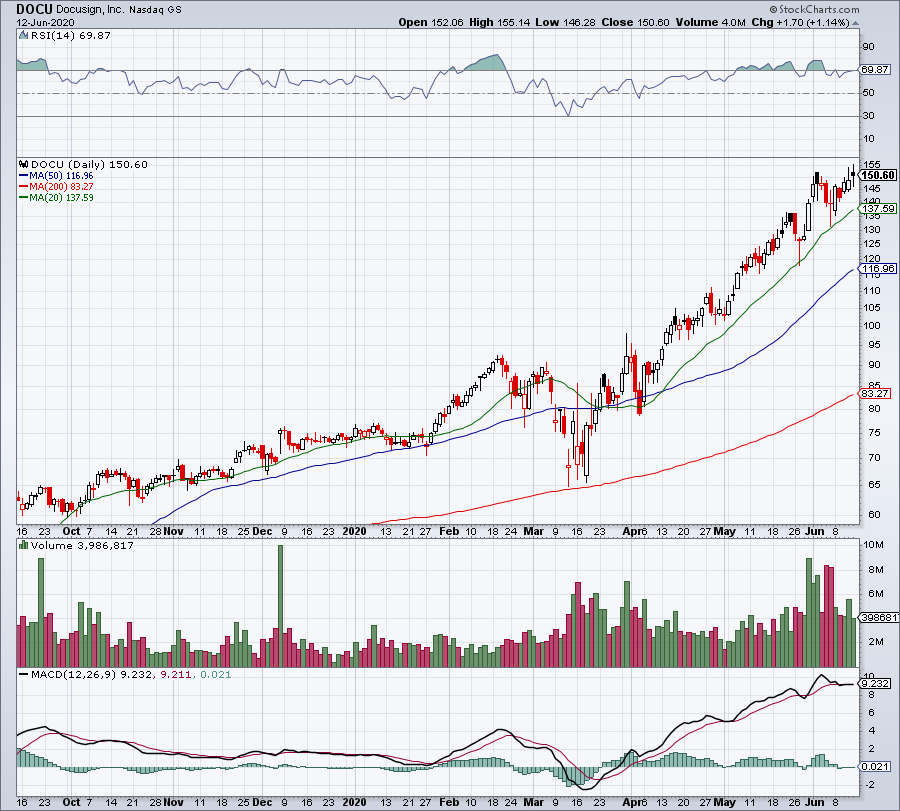I don’t like looking for pandemic stocks. It feels wrong when so many people are sick or out of work to be looking for companies that are benefiting. But whether we embrace this reality or not, there will be certain companies, like DocuSign (NASDAQ:DOCU) that do well.
In that regard, it’s no surprise that DocuSign stock hit a new all-time high on Friday, June 12.
Some companies, like Kroger (NYSE:KR) and Costco (NASDAQ:COST), have benefited as consumers stock up.
Others, like Amazon (NASDAQ:AMZN) and Netflix (NASDAQ:NFLX), benefit as consumers order more online and look for entertainment options.
But what exactly does DocuSign do? In the company’s own words:
“We pioneered the development of e-signature technology, and today DocuSign helps organizations connect and automate how they prepare, sign, act on, and manage agreements. As part of the DocuSign Agreement Cloud, DocuSign offers eSignature: the world’s #1 way to sign electronically on practically any device, from almost anywhere, at any time.”
Tell me that’s not the perfect way for businesses to still get deals done when the novel coronavirus is preventing travel and causing lockdowns. According to the company, its products help lower costs and save time, which is ideal whether we’re talking about a real estate transaction or large deal.
DocuSign Has the Growth
When it comes to DocuSign, there are pros and cons. Let’s start with the pros first, though.
The growth is strong. Analysts forecast revenue to grow about 35% this year, topping $1 billion for the first time by ringing at $1.31 billion. In fiscal 2022 (next year), they expect sales to grow another 28% to almost $1.7 billion.
Further, the company is profitable, with forecasts calling for profit of 48 cents per share this year. In-line results would represent 55% year-over-year growth, with estimates calling for an acceleration next year, up to 75% earnings growth. In-line results in both years would translate to 84 cents per share in earnings in fiscal 2022.
Finally, DocuSign is free cash flow positive. Current assets of $1.04 billion top current liabilities of $729.6 million, meaning the company should have no issue maintaining its short-term obligations.
With all that said, not everything is perfect. First, DocuSign stock is not cheap. Investors looking for growth will find it with this one, but they’ll pay a premium for it too. The stock trades at 21 times this year’s revenue expectations and more than 16 times next year’s estimates.
Additionally, while DocuSign is free cash flow positive, free cash flow isn’t really growing. On the plus side, free cash flow came in at a loss of $48.1 million in fiscal 2017 before turning positive in 2018 at $36 million. Since then though, DocuSign has generated free cash flow of $45.6 million in 2019 and $43.6 million in fiscal 2020.
Are these observations a deal-breaker? No, of course not. But they are something to be aware of, particularly with DocuSign stock trading at all-time highs.
Bottom Line on DocuSign Stock
Earlier this month, DocuSign delivered a top- and bottom-line earnings beat. It provided strong guidance for the coming quarter and full year, including gross margins of 78% to 80% for the latter.
 Source: Chart courtesy of StockCharts.com
Source: Chart courtesy of StockCharts.com
This company isn’t going anywhere — pandemic or not. While Covid-19 could accelerate business thanks to DocuSign allowing people to sidestep in-person interactions, the convenience and cost-savings that it provides is a secular catalyst that doesn’t depend on a pandemic to fuel its growth.
The one downside is actually the stock’s greatest strength at the moment: Momentum.
It has been difficult to catch this stock on the dip simply because there have been almost no dips to buy. Should we see some selling pressure in the overall market, that may be our time to pounce. Let’s see if we get a summer swoon in DocuSign stock.
— Matt McCall
Millionaire Investor Says Second Boom in AI Begins Now [sponsor]Louis Navellier has been ahead of the AI market at every turn. He picked Nvidia way back in May 2019. It's up 2,011% since. He made 372% on Cadence Design and 1,810% on Super Microcomputer. Now he says a second boom in AI is about to begin.
Source: Investor Place



